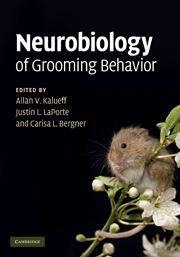Book contents
- Frontmatter
- Contents
- List of contributors
- Preface
- 1 Grooming, sequencing, and beyond: how it all began
- 2 Self-grooming as a form of olfactory communication in meadow voles and prairie voles (Microtus spp.)
- 3 Phenotyping and genetics of rodent grooming and barbering: utility for experimental neuroscience research
- 4 Social play, social grooming, and the regulation of social relationships
- 5 Grooming syntax as a sensitive measure of the effects of subchronic PCP treatment in rats
- 6 Modulatory effects of estrogens on grooming and related behaviors
- 7 Lack of barbering behavior in the phospholipase Cβ1 mutant mouse: a model animal for schizophrenia
- 8 Grooming after cerebellar, basal ganglia, and neocortical lesions
- 9 Striatal implementation of action sequences and more: grooming chains, inhibitory gating, and the relative reward effect
- 10 An ethological analysis of barbering behavior
- 11 Should there be a category: “grooming disorders?”
- 12 Neurobiology of trichotillomania
- Index
- References
10 - An ethological analysis of barbering behavior
Published online by Cambridge University Press: 04 August 2010
- Frontmatter
- Contents
- List of contributors
- Preface
- 1 Grooming, sequencing, and beyond: how it all began
- 2 Self-grooming as a form of olfactory communication in meadow voles and prairie voles (Microtus spp.)
- 3 Phenotyping and genetics of rodent grooming and barbering: utility for experimental neuroscience research
- 4 Social play, social grooming, and the regulation of social relationships
- 5 Grooming syntax as a sensitive measure of the effects of subchronic PCP treatment in rats
- 6 Modulatory effects of estrogens on grooming and related behaviors
- 7 Lack of barbering behavior in the phospholipase Cβ1 mutant mouse: a model animal for schizophrenia
- 8 Grooming after cerebellar, basal ganglia, and neocortical lesions
- 9 Striatal implementation of action sequences and more: grooming chains, inhibitory gating, and the relative reward effect
- 10 An ethological analysis of barbering behavior
- 11 Should there be a category: “grooming disorders?”
- 12 Neurobiology of trichotillomania
- Index
- References
Summary
Summary
“Barbering” is an abnormal behavior in mice. Barbering mice pluck fur and/or whiskers from cage-mates and/or themselves, leaving idiosyncratic patches of hair loss. The behavior is a paradox: barbering is common in laboratory mice, but it is not seen in wild mice, it does not benefit the plucker, and it is costly to the recipient. This chapter will attempt to resolve the barbering paradox by asking how and why barbering behavior occurs. Using Tinbergen's (1963) framework for an ethological analysis, we assess barbering in terms of adaptive function, phylogeny, development, and mechanism.
The first section discusses hypotheses of adaptive function. The dominance hypothesis is refuted by several studies; the coping hypothesis remains untested; and the pathology hypothesis is supported by multiple lines of evidence. The pathology hypothesis therefore provides the best resolution to the barbering paradox. Accordingly, throughout, we compare and contrast barbering to trichotillomania (TTM) and other human disorders characterized by repetitive behavior. The second section assesses the phylogenetic underpinnings of barbering by comparing and contrasting hair-plucking behavior across species and between mouse strains. The third section reviews the developmental processes that underlie barbering behavior, particularly developmental risk factors, learning, the laboratory environment, and transgenic effects. The final section reviews the behavioral mechanisms, eliciting stimuli, and physiological mechanisms that might mediate barbering. Here, we outline the role of cortico–striatal circuitry in abnormal repetitive behavior in general, how it can be used to delineate disorders, and insights it provides into barbering.
- Type
- Chapter
- Information
- Neurobiology of Grooming Behavior , pp. 184 - 225Publisher: Cambridge University PressPrint publication year: 2010
References
- 4
- Cited by



